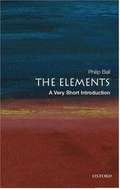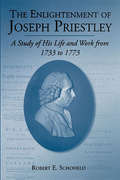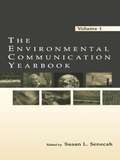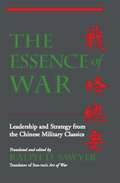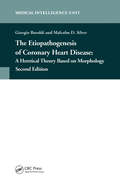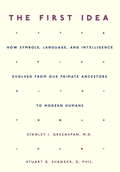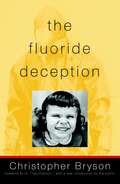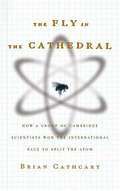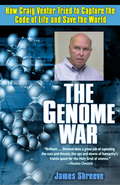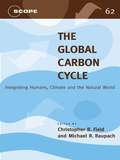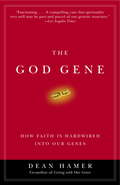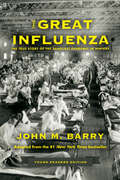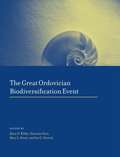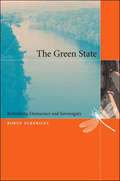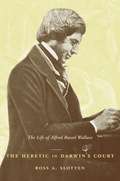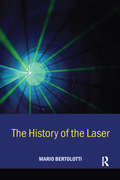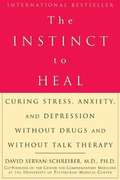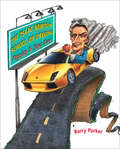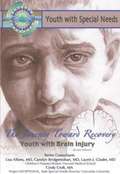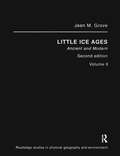- Table View
- List View
The Elements: A Very Short Introduction
by Philip BallThis Very Short Introduction is an exciting and non-traditional approach to understanding the terminology, properties, and classification of the chemical elements. It traces the history and cultural impact of the elements on humankind, and examines why people have long sought to identify the substances around them. The book includes chapters on particular elements such as gold, iron, and oxygen, showing how they shaped culture and technology. Looking beyond the Periodic Table, the author examines our relationship with matter, from the uncomplicated vision of the Greek philosophers, who believed there were four elements--earth, air, fire, and water--to the work of modern-day scientists in creating elements such as hassium and meitnerium. Packed with anecdotes, The Elements is a highly engaging and entertaining exploration of the fundamental question: what is the world made from?
The Enlightened Joseph Priestley: A Study of His Life and Work from 1733 to 1773
by Robert SchofieldJoseph Priestley (1733–1804) is one of the major figures of the English Enlightenment. A contemporary and friend of Benjamin Franklin and Thomas Jefferson, he exceeded even these polymaths in the breadth of his curiosity and learning. Yet no one has attempted an all-inclusive biography of Priestley, probably because he was simply too many persons for anyone easily to comprehend in a single study. Robert Schofield has devoted a lifetime of scholarship to this task. The result is a magisterial book, covering the life and works of Priestley during the critical first forty years of his life. <P><P>Although Priestley is best known as a chemist, this book is considerably more than a study in the history of science. As any good biographer must, Schofield has thoroughly studied the many activities in which Priestley was engaged. Among them are theology, electricity, chemistry, politics, English grammar, rhetoric, and educational philosophy. Schofield situates Priestley, the provincial dissenter, within the social, political, and intellectual contexts of his day and examines all the works Priestley wrote and published during this period. <P><P>Schofield singles out the first forty years of Priestley's life because these were the years of preparation and trial during which Priestley qualified for the achievements that were to make him famous. The discovery of oxygen, the defenses of Unitarianism, and the political liberalism that characterize the mature Priestley—all are foreshadowed in the young Priestley. A brief epilogue looks ahead to the next thirty years when Priestley was forced out of England and settled in Pennsylvania, the subject of Schofield's next book. But this volume stands alone as the definitive study of the making of Joseph Priestley.
The Environmental Communication Yearbook: Volume 1
by Susan L. SenecahEditorial ScopeThe Environmental Communication Yearbook is a multidisciplinary forum through which a broad audience of academics, professionals, and practitioners can share and build theoretical, critical, and applied scholarship addressing environmental communication in a variety of contexts. This peer-reviewed annual publication invites submissions that showcase and/or advance our understanding of the production, reception, contexts, or processes of human communication regarding environmental issues. Theoretical expositions, literature reviews, case studies, cultural and mass media studies, best practices, and essays on emerging issues are welcome, as are both qualitative and quantitative methodologies. Areas of topical coverage will include:*participatory processes: public participation, collaborative decision making, dispute resolution, consensus building processes, regulatory negotiations, community dialogue, building civic capacity;*journalism and mass communications: newspaper, magazine, book and other forms of printed mass media; advertising and public relations; media studies; and radio, television, and Internet broadcasting; and*communication studies: rhetorical/historical case studies, organizational analyses, public relations/issues management, interpersonal/relational dimensions, risk communication, and psychological/cognitive research, all of which examine the origins, content, structure, and outcomes of discourse about environmental issues. Submissions are accepted on an ongoing basis for inclusion in volumes published annually. AudienceResearchers, scholars, students and practitioners in environmental communication, journalism, rhetoric, public relations, mass communication, risk analysis, political science, environmental education, environmental studies, public administrations; policymakers; others interested in environmental issues and the communication channels used for discourse and information dissemination on the topic.For more information and guidelines for submissions, visit www.erlbaum.com/ecy.htm.
The Essence of War: Leadership and Strategy from the Chinese Military Classics
by Ralph D. SawyerFrom antiquity, the history of China has been marked by invading tribes, warring states, and popular uprisings. This heritage of conflict produced a body of martial literature exploring the fundamental principles of warfare and their methods of employment. Fully aware of the tragic consequences of battle, the authors of these texts emphasized that bloodshed and war should be avoided whenever possible. But, they argued, this is possible only when the principles of leadership and strategy have been mastered and the dynamics of conflict thoroughly analyzed. Over the centuries, these texts have been studied throughout Asia, not only by generals on the battlefield but by leaders of all kinds concerned with the management of human conflict in all its forms. The Essence of War presents eight of these classics (written from 500 B. C. E. to 700 C. E. ), including Sun-tzu's Art of War and Sun Pin's Military Methods. The book introduces the core principles of Chinese military science, grouping selected passages and key quotations into five thematic sections encompassing forty-one topical chapters: Fundamentals, Tao of Warfare, Tao of Command, Tactical Essentials, and Tactical Specifics. Translator Ralph D. Sawyer provides here a concise introduction to Chinese military thought and influential materials not only of traditional import, but also for contemporary study and enduring value in both business and military circles throughout the world.
The Etiopathogenesis of Coronary Heart Disease: A Heretical Theory Based on Morphology, Second Edition
by Giorgio Baroldi Malcolm D. SilverThe natural history of a heretic viewpoint on the functional significance of morphologic findings. Comparative pathologic study.Natural history of the human coronary atherosclerotic plaque and related forms of myocardial injuries.Findings in acute coronary syndromes.Revisiting dogma related to coronary artery disease.Adrenergic stress.
The Fabric of the Cosmos: Space, Time, and the Texture of Reality (Penguin Press Science Ser.)
by Brian GreeneFrom Brian Greene, one of the world's leading physicists and author the Pulitzer Prize finalist The Elegant Universe, comes a grand tour of the universe that makes us look at reality in a completely different way.Space and time form the very fabric of the cosmos. Yet they remain among the most mysterious of concepts. Is space an entity? Why does time have a direction? Could the universe exist without space and time? Can we travel to the past? Greene has set himself a daunting task: to explain non-intuitive, mathematical concepts like String Theory, the Heisenberg Uncertainty Principle, and Inflationary Cosmology with analogies drawn from common experience. From Newton's unchanging realm in which space and time are absolute, to Einstein's fluid conception of spacetime, to quantum mechanics' entangled arena where vastly distant objects can instantaneously coordinate their behavior, Greene takes us all, regardless of our scientific backgrounds, on an irresistible and revelatory journey to the new layers of reality that modern physics has discovered lying just beneath the surface of our everyday world.From the Trade Paperback edition.
The First Idea: How Symbols, Language, and Intelligence Evolved from our Primate Ancestors to Modern Humans
by Stanley I. Greenspan Stuart G. ShankerIn the childhood of every human being and at the dawn of human history there is an amazing and, until now, unexplained leap from simple genetically programmed behavior to language, symbolic thinking, and culture. In The First Idea, Stanley Greenspan and Stuart Shanker explore this missing link and offer brilliant new insights into two longstanding questions: how human beings first create symbols and how these abilities evolved and were transmitted across generations over millions of years. From fascinating research into the intelligence of both human infants and apes, they identify certain cultural practices that are vitally important if we are to have stable and reflective future societies.
The Fluoride Deception
by Theo Colborn Christopher BrysonWith the narrative punch of Jonathan Harr's A Civil Action and the commitment to environmental truth-telling of Erin Brockovich, The Fluoride Deception documents a powerful connection between big corporations, the U.S. military, and the historic reassurances of fluoride safety provided by the nation's public health establishment. The Fluoride Deception reads like a thriller, but one supported by two hundred pages of source notes, years of investigative reporting, scores of scientist interviews, and archival research in places such as the newly opened files of the Manhattan Project and the Atomic Energy Commission. The book is nothing less than an exhumation of one of the great secret narratives of the industrial era: how a grim workplace poison and the most damaging environmental pollutant of the cold war was added to our drinking water and toothpaste.
The Fly in the Cathedral
by Brian CathcartThis book describes how a group of Cambridge scientists won the international race to split the atom.
The Genome War
by James ShreeveThe long-awaited story of the science, the business, the politics, the intrigue behind the scenes of the most ferocious competition in the history of modern science--the race to map the human genome.On May 10, 1998, biologist Craig Venter, director of the Institute for Genomic Research, announced that he was forming a private company that within three years would unravel the complete genetic code of human life--seven years before the projected finish of the U.S. government's Human Genome Project. Venter hoped that by decoding the genome ahead of schedule, he would speed up the pace of biomedical research and save the lives of thousands of people. He also hoped to become very famous and very rich. Calling his company Celera (from the Latin for "speed"), he assembled a small group of scientists in an empty building in Rockville, Maryland, and set to work.At the same time, the leaders of the government program, under the direction of Francis Collins, head of the National Human Genome Research Institute at the National Institutes of Health, began to mobilize an unexpectedly unified effort to beat Venter to the prize--knowledge that had the potential to revolutionize medicine and society. The stage was set for one of the most thrilling--and important--dramas in the history of science. The Genome War is the definitive account of that drama--the race for the greatest prize biology has had to offer, told by a writer with exclusive access to Venter's operation from start to finish. It is also the story of how one man's ambition created a scientific Camelot where, for a moment, it seemed that the competing interests of pure science and commercial profit might be gloriously reconciled--and the national repercussions that resulted when that dream went awry.From the Hardcover edition.
The Genome War
by James ShreeveThe long-awaited story of the science, the business, the politics, the intrigue behind the scenes of the most ferocious competition in the history of modern science--the race to map the human genome.On May 10, 1998, biologist Craig Venter, director of the Institute for Genomic Research, announced that he was forming a private company that within three years would unravel the complete genetic code of human life--seven years before the projected finish of the U.S. government's Human Genome Project. Venter hoped that by decoding the genome ahead of schedule, he would speed up the pace of biomedical research and save the lives of thousands of people. He also hoped to become very famous and very rich. Calling his company Celera (from the Latin for "speed"), he assembled a small group of scientists in an empty building in Rockville, Maryland, and set to work.At the same time, the leaders of the government program, under the direction of Francis Collins, head of the National Human Genome Research Institute at the National Institutes of Health, began to mobilize an unexpectedly unified effort to beat Venter to the prize--knowledge that had the potential to revolutionize medicine and society. The stage was set for one of the most thrilling--and important--dramas in the history of science. The Genome War is the definitive account of that drama--the race for the greatest prize biology has had to offer, told by a writer with exclusive access to Venter's operation from start to finish. It is also the story of how one man's ambition created a scientific Camelot where, for a moment, it seemed that the competing interests of pure science and commercial profit might be gloriously reconciled--and the national repercussions that resulted when that dream went awry.From the Hardcover edition.
The Genome War: How Craig Venter Tried to Capture the Code of Life and Save the World
by James ShreeveBiologist Craig Venter founded the company Celera in an effort to decode the human genome before the U. S. government's Human Genome Project, expecting to get very rich in the process. This book chronicles the company's work in the 1990s, looking at the economic, political, scientific, and institutional rivalries and competitions that eventually led to the company's eventual implosion. Annotation ©2004 Book News, Inc. , Portland, OR (booknews. com)
The Global Carbon Cycle: Integrating Humans, Climate, and the Natural World (SCOPE Series #62)
by Christopher B. Field Michael R. Raupach Susan Hill MackenzieWhile a number of gases are implicated in global warming, carbon dioxide is the most important contributor, and in one sense the entire phenomena can be seen as a human-induced perturbation of the carbon cycle. The Global Carbon Cycle offers a scientific assessment of the state of current knowledge of the carbon cycle by the world's leading scientists sponsored by SCOPE and the Global Carbon Project, and other international partners. It gives an introductory over-view of the carbon cycle, with multidisciplinary contributions covering biological, physical, and social science aspects. Included are 29 chapters covering topics including: an assessment of carbon-climate-human interactions; a portfolio of carbon management options; spatial and temporal distribution of sources and sinks of carbon dioxide; socio-economic driving forces of emissions scenarios. Throughout, contributors emphasize that all parts of the carbon cycle are interrelated, and only by developing a framework that considers the full set of feedbacks will we be able to achieve a thorough understanding and develop effective management strategies. The Global Carbon Cycle edited by Christopher B. Field and Michael R. Raupach is part of the Rapid Assessment Publication series produced by the Scientific Committee on Problems of the Environment (SCOPE), in an effort to quickly disseminate the collective knowledge of the world's leading experts on topics of pressing environmental concern.
The God Gene
by Dean HamerLEADING GENETICIST DEAN HAMER CRACKS THE "CODE" BEHIND WHY WE ARE PREDISPOSED TO BELIEVE IN GOD. IN A BOOK THAT BRIDGES THE GAP BETWEEN RELIGION AND SCIENCE," HAMER BRILLIANTLY ILLUMINATES HOW OUR INCLINATION TOWARD FAITH IS INFLUENCED BY OUR GENES. The overwhelming majority of Americans believe in God, expressing a conviction that has existed since the beginning of recorded time and is shared by billions around the world. In "The God Gene, Dr. Dean Hamer reveals that this inclination toward religious faith is no accident; it is in good measure due to our genes. In fact, he argues, spiritual belief may offer an evolutionary advantage by providing humans with a sense of purpose and the courage and will to overcome hardship and loss. And, as a growing body of evidence suggests, belief also increases our chances of reproductive survival by helping to reduce stress, prevent disease, and extend life. Hamer shows that new discoveries in behavioral genetics and neurobiology indicate that humans inherit a set of predispositions that make their brains ready and eager to embrace a higher power. By analyzing the genetic makeup of over a thousand people of different ages and backgrounds, and comparing their DNA samples against a scale that measures spirituality, Hamer actually identified a specific "God gene" that appears to influence spirituality. Popular science at its best, "The God Gene is an in-depth, fully accessible inquiry into the cutting-edge research that is changing the way we think about ourselves, our world, and our culture. Written with balance and integrity, without seeking to confirm or deny the existence of God, "The God Gene brilliantly illuminates the mechanismby which belief itself is biologically fostered. It's a book that bridges the gap between science and religion, and one that will appeal to the readers of Genesis and "Genome alike.
The Great Influenza: The True Story of the Deadliest Pandemic in History (Young Readers Edition)
by John M. BarryThe strongest weapon against pandemic is the truth. Read why in the definitive account of the 1918 Influenza Epidemic, adapted for young readers from the #1 New York Times bestseller.At the height of World War I, history&’s most lethal influenza virus erupted in an army camp in Kansas, moved east with American troops, and then exploded worldwide, killing as many as 100 million people. It killed more in twenty-four months than AIDS killed in twenty-four years, more in a year than the Black Death killed in a century. It killed many more people than COVID-19, especially those who were young and otherwise healthy.This book, adapted from the #1 New York Times bestseller first published in 2004, shows young readers how this global tragedy came to pass; how science, war, and public policy collided; and how we might be able to prevent it from happening again. Impeccably researched and engrossingly told, The Great Influenza provides young readers with historical and scientific context for epidemics that remains all too relevant today.
The Great Ordovician Biodiversification Event
by Florentin Paris Mary L. Droser Ian G. Percival Barry D. WebbyTwo of the greatest evolutionary events in the history of life on Earth occurred during Early Paleozoic time. The first was the Cambrian explosion of skeletonized marine animals about 540 million years ago. The second was the "Great Ordovician Biodiversification Event," which is the focus of this book. This is the first book devoted specifically to establishing the global patterns of differentiation of Ordovician biotas through time and space. It provides extensive genus- and species-level diversity data for the many Ordovician fossil groups and presents an evaluation of how each group diversified, with assessments of patterns of change, and rates of origination and extinction.
The Great Ordovician Biodiversification Event (The Critical Moments and Perspectives in Earth History and Paleobiology)
by Barry D. Florentin Paris Mary L. Droser Ian G. Percival Eds. WebbyTwo of the greatest evolutionary events in the history of life on Earth occurred during Early Paleozoic time. The first was the Cambrian explosion of skeletonized marine animals about 540 million years ago. The second was the "Great Ordovician Biodiversification Event," which is the focus of this book. During the 46-million-year Ordovician Period (489–443 m.y.), a bewildering array of adaptive radiations of "Paleozoic- and Modern-type" biotas appeared in marine habitats, the first animals (arthropods) walked on land, and the first non-vascular bryophyte-like plants (based on their cryptospore record) colonized terrestrial areas with damp environments.This book represents a compilation by a large team of Ordovician specialists from around the world, who have enthusiastically cooperated to produce this first globally orientated, internationally sponsored IGCP (International Geological Correlation Program) project on Ordovician biotas. The major part is an assembly of genus- and species-level diversity data for the many Ordovician fossil groups. The book also presents an evaluation of how each group diversified through Ordovician time, with assessments of patterns of change and rates of origination and extinction. As such, it will become the standard work and data source for biotic studies on the Ordovician Period.
The Green State: Rethinking Democracy and Sovereignty
by Robyn EckersleyWhat would constitute a definitively "green" state? In this important new book, Robyn Eckersley explores what it might take to create a green democratic state as an alternative to the classical liberal democratic state, the indiscriminate growth-dependent welfare state, and the neoliberal market-focused state—seeking, she writes, "to navigate between undisciplined political imagination and pessimistic resignation to the status quo." In recent years, most environmental scholars and environmentalists have characterized the sovereign state as ineffectual and have criticized nations for perpetuating ecological destruction. Going consciously against the grain of much current thinking, this book argues that the state is still the preeminent political institution for addressing environmental problems. States remain the gatekeepers of the global order, and greening the state is a necessary step, Eckersley argues, toward greening domestic and international policy and law.The Green State seeks to connect the moral and practical concerns of the environmental movement with contemporary theories about the state, democracy, and justice. Eckersley's proposed "critical political ecology" expands the boundaries of the moral community to include the natural environment in which the human community is embedded. This is the first book to make the vision of a "good" green state explicit, to explore the obstacles to its achievement, and to suggest practical constitutional and multilateral arrangements that could help transform the liberal democratic state into a postliberal green democratic state. Rethinking the state in light of the principles of ecological democracy ultimately casts it in a new role: that of an ecological steward and facilitator of transboundary democracy rather than a selfish actor jealously protecting its territory.
The Heretic in Darwin's Court: The Life of Alfred Russel Wallace
by Ross A. SlottenThe Heretic in Darwin's Court explores the controversial life and scientific contributions of Alfred Russel Wallace-Victorian traveler, spiritualist, and scientist who proposed the theory of natural selection with his noted colleague, Charles Darwin. In this biography, Ross A. Slotten recounts Wallace's twelve years of harrowing travels in the western and eastern tropics, which place him in the pantheon of the greatest explorer-naturalists of the nineteenth century. The remaining fifty years of Wallace's life were just as controversial. In addition to diverging from Darwin on two fundamental issues-sexual selection and the origin of the human mind-Wallace pursued topics that most scientific figures of his day conspicuously avoided, including spiritualism, phrenology, mesmerism, environmentalism, and life on Mars.The Heretic in Darwin's Court casts new light on Wallace's intellectual investigations into the origins of life, consciousness, and the universe itself. His achievements remain some of the most inspired scientific accomplishments in history.
The Heretic in Darwin’s Court: The Life of Alfred Russel Wallace
by Ross SlottenDuring their lifetimes, Alfred Russel Wallace and Charles Darwin shared credit and fame for the independent and near-simultaneous discovery of natural selection. Together, the two men spearheaded one of the greatest intellectual revolutions in modern history, and their rivalry, usually amicable but occasionally acrimonious, forged modern evolutionary theory. Yet today, few people today know much about Wallace.The Heretic in Darwin's Court explores the controversial life and scientific contributions of Alfred Russel Wallace—Victorian traveler, scientist, spiritualist, and co-discoverer with Charles Darwin of natural selection. After examining his early years, the biography turns to Wallace's twelve years of often harrowing travels in the western and eastern tropics, which place him in the pantheon of the greatest explorer-naturalists of the nineteenth century. Tracing step-by-step his discovery of natural selection—a piece of scientific detective work as revolutionary in its implications as the discovery of the structure of DNA—the book then follows the remaining fifty years of Wallace's eccentric and entertaining life. In addition to his divergence from Darwin on two fundamental issues—sexual selection and the origin of the human mind—he pursued topics that most scientific figures of his day conspicuously avoided, including spiritualism, phrenology, mesmerism, environmentalism, and life on Mars.Although there may be disagreement about his conclusions, Wallace's intellectual investigations into the origins of life, consciousness, and the universe itself remain some of the most inspired scientific accomplishments in history. This authoritative biography casts new light on the life and work of Alfred Russel Wallace and the importance of his twenty-five-year relationship with Charles Darwin.
The History of the Laser
by Mario BertolottiSince the invention of the first working laser in 1960, development of these devices has progressed at an unprecedented rate, to the extent that the laser is now a common part of everyday life, from the semiconductor laser used in CD players and telecommunication systems to the high power eximer lasers used in manufacturing processes. This book tra
The Instinct to Heal: Curing Stress, Anxiety, and Depression without Drugs and Without Talk Therapy
by David Servan-SchreiberRecent discoveries about the emotional brain show we can heal naturally from stress and depression. Award-winning psychiatrist and neuroscientist David Servan-Schreiber, M.D., Ph.D., presents seven methods for faster, more dramatic, and permanent results for patients who want to leave suffering behind and live joyful, happy lives.<P> The methods presented in this book, taken from case histories, have all been proven to work in clinical tests. They are based on the self-healing mechanisms of the emotional brain, which controls the body, as opposed to the cognitive brain, which manipulates symbols and language. Dr. Servan-Schreiber considers the influence of the heart upon the brain, explores the use of EMDR (eye-movement desensitization and reprocessing) to recover from trauma, and explains how to reset your biological clock to avoid symptoms from seasonal depression.<P> We learn how the biochemistry of touch and love can heal emotional wounds, and we also learn how to use acupuncture, nutrition, and exercise to control our moods. An international bestseller, this is the first book on the market to answer the public's questions about the new alternatives to conventional psychopharmaceuticals, as well as traditional talk therapy. By reprogramming their emotional brains, people struggling with stress, anxiety, and depression can rediscover the balance and well-being needed to transform their lives.
The Isaac Newton School of Driving: Physics and Your Car
by Barry ParkerFor some people, driving is an art; for others, it's a science. At the Isaac Newton School of Driving, though, every car is a laboratory on wheels and every drive an exciting journey into the world of physics. As explained by renowned science writer and physics professor Barry Parker—whose father was a car mechanic and garage owner—almost every aspect of driving involves physics. A car's performance and handling relies on fundamental concepts such as force, momentum, and energy. Its ignition system depends on the principles of electricity and magnetism. Braking relies on friction—yet another basic scientific concept—and if the brakes fail, the resulting damage, too, can be predicted using physics.Parker's first lesson describes the basic physics of driving: speed and acceleration; why you get thrown forward while braking or outward while turning; and why car advertisements boast about horsepower and torque. He goes on to discuss the thermodynamics of engines, and how they can be more fuel efficient; and what friction and traction are and how they keep a car's tires on the road, whether it's dry, wet, or icy. He also describes how simple laws of physics enable scientists to design aerodynamic cars and high-tech steering systems. Parker then explores the high-performance physics of auto racing, outlines how traffic accidents are reconstructed by police, uses chaos theory to explain why traffic jams happen, and describes what cars of the future might look like. Whether you drive a Pacer or a Porsche, The Isaac Newton School of Driving offers better—and better-informed—driving through physics.
The Journey Toward Recovery: Youth with Brain Injury (Youth with Special Needs)
by Joan EsherickJerome pedaled down the mountain, his friends Tommy and Eric racing to catch up. The wide, flat path was made for smooth riding, but Jerome's mind wasn't on the trail. A sudden rustling in the brush ahead startled him out of his daydreaming. A dog darted out of the shrubs, then stopped dead in the trail. The next several seconds seemed to pass in slow motion. Jerome squeezed hard on the hand brakes, but it was too late. His front wheel collided with the animal; the dog yelped; and Jerome somersaulted over his handlebars. Tommy said later he would never forget how his friend flew through the air and collided head-on with the sycamore tree. Eric said he'd never forget the sickening thud the impact made. But what his friends would never forget, Jerome would never remember. In a brilliant white flash, Jerome's life as he knew it was gone. What do bikes, cars, scooters, sports, tumors, strokes, guns, and the shaking of babies all have in common? They all can cause brain injuries. Every twenty-one seconds, one person in the United States sustains a traumatic brain injury. In The Journey Toward Recovery: Youth with Brain Injury you will read about Jerome, one teen who finds his life changed forever in a split-second accident. Along the way, you will also learn about other forms of brain injury; how these injuries affect people's lives; and how schools, doctors, and lawmakers are helping youth with this form of special need.
The Little Ice Age: Ancient And Modern (Routledge Studies In Physical Geography Ser. #Vol. 5)
by Jean M. GroveThe evidence for the Little Ice Age, the most important fluctuation in global climate in historical times, is most dramatically represented by the advance of mountain glaciers in the sixteenth and seventeenth centuries and their retreat since about 1850. The effects on the landscape and the daily life of people have been particularly apparent in Norway and the Alps. This major book places an extensive body of material relating to Europe, in the form of documentary evidence of the history of the glaciers, their portrayal in paintings and maps, and measurements made by scientists and others, within a global perspective. It shows that the glacial history of mountain regions all over the world displays a similar pattern of climatic events. Furthermore, fluctuations on a comparable scale have occurred at intervals of a millennium or two throughout the last ten thousand years since the ice caps of North America and northwest Europe melted away. This is the first scholarly work devoted to the Little Ice Age, by an author whose research experience of the subject has been extensive. This book includes large numbers of maps, diagrams and photographs, many not published elsewhere, and very full bibliographies. It is a definitive work on the subject, and an excellent focus for the work of economic and social historians as well as glaciologists, climatologists, geographers, and specialists in mountain environment.
